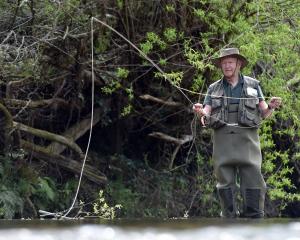Where I live on the Taieri Plain, we had a dry year last year, which caused rivers to be very low at times — except during the big flood in February, which mainly affected rivers to the south.
With only three weeks to go in the year, rainfall is down more than 100mm on last year, and consequently streams are low and dropping quickly.
Most of them are in good fishing order but, as we all know, it just takes a couple of days of heavy rain to make them unfishable. However, if we do not receive enough rainfall, we will have to cope with very low water and the problems it produces — high water temperatures and excessive weed growth.
I am trying to make sure that I can make the most of the conditions prevailing at the moment.
While waters are low, bigger rivers are easier to fish and the best are the Pomahaka, Taieri and Mataura.
Warm days are ideal for lots of insects to appear on rivers with a good chance that fish will rise to them. General fly patterns work well — a brown nymph regardless of its name will catch fish, as will a bushy dry fly. A coch-y-bondhu would be my pick. Of course, if you can identify a specific insect that trout are rising to, match it as close as you can.
If you have the luxury of living close to a stream and can pop out for a couple of hours at dusk on a nice evening there will almost certainly be some fish rising. The beauty of rising fish is that you know exactly where to place the fly, as the most important part of catching a fish on fly is to be sure that the fish sees your fly. If it does not take after several attempts, try something different.
Writing that last sentence reminded me of a fish I found rising steadily on the Pomahaka last weekend.
It was rising under some willows in the shade and I was lucky to be looking in the right place when it swirled at something. There were a few duns hatching and I had already seen a fish taking nymphs beneath the surface, so I covered it with an unweighted hare’s ear nymph, which had already accounted for one fish.
After several casts that failed to interest the fish, I tied on an CDC emerger. I chose the emerger as the trout was not rising head and tail, which typifies a rise to duns. It turned out to be the right choice as it took straight away. The next fish ignored the emerger and turning back to the nymph produced the desired effect.
For the rest of the morning, I kept the nymph on and picked up the odd fish that was rising and one or two that were cruising the shallows on the flat water.






